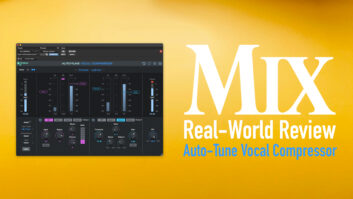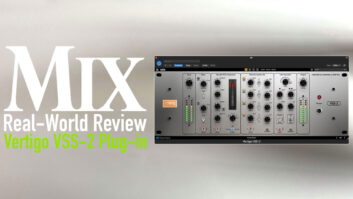
The Lisson Grove R-124 single-channel, variable-mu compressor is an homage to the EMI/Abbey Road RS124, which itself started out life as the U.S.-made Altec 436B compressor originally released in 1958 for telephone and broadcast use. American recording engineers found them unreliable, lacking good bass response, and mostly ignored them. EMI’s engineers recognized the Altec’s potential and made extensive circuitry changes, tube substitutions and operational modifications, transforming the unit into the superior-sounding RS124. The RS124 was used exclusively at Abbey Road and other EMI studios throughout the world. It became a big part of the “British Sound,” appearing on countless records in the ’60s and ’70s.
The Lisson Grove R-124 builds on the RS124’s legacy with further refinements, enhanced reliability and some modern touches—all without deviating far from the original’s core sonics.

BUILT LIKE A BRITISH CHALLENGER II TANK
The U.S.-made, two-rackspace R-124 comes in an all-steel cabinet painted with a super-thick and scratch-resistant industrial coating. The “chicken-head” knobs, institutional-green front panel, vintage jewel pilot light and antique-looking Hoyt Electric gain reduction VU meter all combine to give it a militaristic retro look.
Inside, a steel truss panel running the width of the unit supports the main circuit board on one side, and three horizontally mounted tubes on the other. The power supply board is mounted on the inside of the unit’s back panel and has a switchable 110/220 VAC mains IEC socket.
Point-to-point hand-wiring is used throughout, with pots made by Pec or Alpha, switches by Carling, and critical audio capacitors from Auricaps and Solen. The three tubes (6ES8, 6CG7 and 6AL5) are in ceramic sockets but without hold-down brackets. Sowter makes the input transformer; the output transformer is a custom-made CineMag.
To counteract changes in sound and operation over time caused by tube aging, component drift and the quirky 1950 circuit design, the R-124 (like the EMI RS124) uses a clever tube-balancing method. With the unit connected and patched, pushing a front panel button activates a NE-2 neon bulb relaxation oscillator circuit that sends a 3Hz pulse to both cathodes of the triode halves of the 6ES8 push-pull input stage, causing a low-level “ticking” sound in the unit’s output.

The recording engineer would then adjust a lockable front panel trim pot labeled Balance so that this ticking sound is at minimum, indicating that both triode halves are balanced. This 20-second procedure is required one or two times a month and can be done at any time—even during a session.
WHAT’S THE DIFFERENCE?
The R-124 comes with a continuously variable attack time control with a range of 15 ms to 125 ms, along with a new O/P Load control feature. O/P’s front panel control sets the R-124’s output impedance anywhere between (CCW) 200 ohms (labeled “Dark”) to 600 ohms (CW). Also new is a rear panel, ¼-inch link jack for stereo operation of two R-124s, with the unit that is compressing more acting as the master.
Release operation is also completely “remixed” on the R-124. A faster release time replaces the RS124’s fastest position—it’s now 310 ms on the R-124, with all other five release times the same as on the RS124.
Like the RS124, the R-124’s Release rotary switch allows access to the compressor’s unique Hold or Infinity mode. As soon as you switch to Hold, the current amount of gain reduction at that moment is “frozen,” with no recovery of gain back to unity as is typical of a compressor. To engage Hold, there are six interstitial switch positions between the six release time positions, making the Hold mode always one click away from any selected release time.
For hands-free operation of Hold, there is a ¼-inch rear TS panel jack for connecting a normally open footswitch (not included). Shorting the tip to the sleeve returns the unit to normal operation.
IN THE STUDIO
Operating the R-124’s input, output, attack and release controls reminded me of setting up a UA 1176LN peak limiter except without threshold or ratio controls—much easier. Simply turn up the R-124’s input level control to set the amount of compression and adjust output to makeup gain.
During a mix, a young female singer’s overly dynamic vocal tracks were easily managed by the R-124. I used the fastest attack time and the number 3 release position. With input at nearly full CW, I saw 20 dB of gain reduction resulting in a solid sound that revealed the singer’s every vocal nuance and detail. This worked well for the lead vocal track to keep it “tucked in” and not overpowering the dense rock track I was mixing.
However, with 20 dB of makeup gain in the chain, in between the singer’s phrases I could also hear headphone spill, the tube mic/preamp noise floor and the producer talking in the next room! Plus, the song’s “call and response” vocal production meant that several seconds of time elapsed between lead vocal sections. Every time the singer started in on the next section, the R-124 attacked and started gain reduction, but, because the release time had expired, there was a tremendous “pop” at the front of her first note.
Hold allowed me to freeze the release time (and therefore gain reduction) at the last moment of the singer’s previous section. When my singer came back in, I immediately clicked out of Hold and avoided an attack “pop.” The R-124, already in GR, was back to normal operation with the vocal at about the same volume. I found this process easy to do and liked having the option to use it or not.
Processing direct Fender bass is great fun—you can compress to needle-pinning depths off scale—around 25 dB and it sounds fat, rich and super-dense. I was working on a song in drop D tuning and the bass player’s performance and sound was good, but it was not “reading” well in the final mix.
I went with the R-124’s input control at 9, output at 8, attack time control straight up and the fastest release. In spite of the fast release time and about 15 dB of squash, the R-124 did not distort sustained bass notes. The bass track had about a 3dB dynamic range, stayed “in your face” at all times and took on raucous character as if we had used a bass amp that was about to explode.
Here, the O/P Load function became useful because at the 600-ohm position, this bass was too bright, so I went halfway between the darker 200 and full-range 600 ohm. I found O/P’s tonal range to be vast for an effect anywhere from subtle to dramatic.
Pulling out on the R-124’s Attack knob switches to a throughput bypass—audio passes through the unit without compression. Because this is not a true bypass, switching to it will necessitate all-new level settings. In a future R-124 version, I’d like to see a hardwired bypass switch because doing A/Bs should be easier.
I had a lot of fun overdriving the R-124 by winding up the input control. I liked the many analog colors possible, from subtle warming to brutal distortion. On the Dark side of the O/P control, the sound fuzzes out, low frequencies thin out and the output level decreases. Toward the 600-ohm side, high fidelity is returned.
Bypass worked well for overly clean electric guitars that I wanted to “throw out into the street” and rough up. Different combinations of O/P and input settings offer many tonal choices, from somber and dire to brighter and full-sounding.
A Martin D18 acoustic sounded better after a pass through the R-124. I preferred barely compressing (4dB max) with the slowest attack time setting, release set to 1 or 2, and O/P set at full 600 ohms for an open sound.
Individual drum tracks, loops, a mono drum mix bus and most percussion are also good subjects for the R-124’s magic. Even under massive compression (greater than 10 dB), the sound does not dull out and lose high frequencies. Set the attack time anywhere from 12 o’clock to faster, release on either 1 or 2, and O/P set to 12 o’clock or higher.
OLD IS ALL-NEW
The Lisson Grove R-124 compressor is like a glimpse into the toolkit of English recording engineers working at Abbey Road circa 1960. It’s not perfect, it’s not pristine and it’s not like any other compressor. It sounds distinctive and is one of my favorite compressors of all time.
Barry Rudolph is an L.A.-based recording engineer. Visit him at barryrudolph.com.








